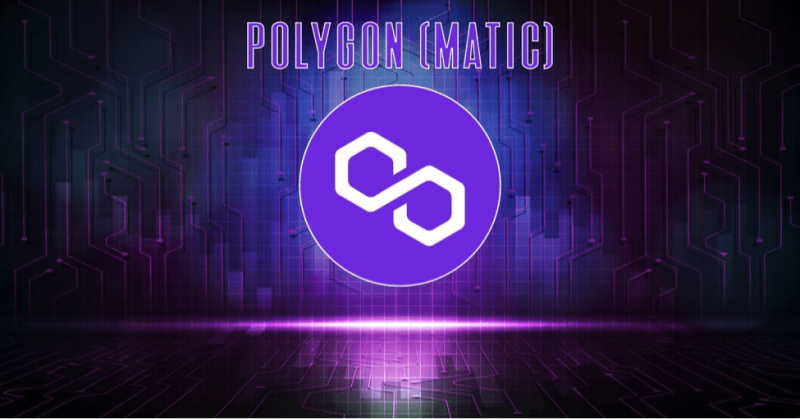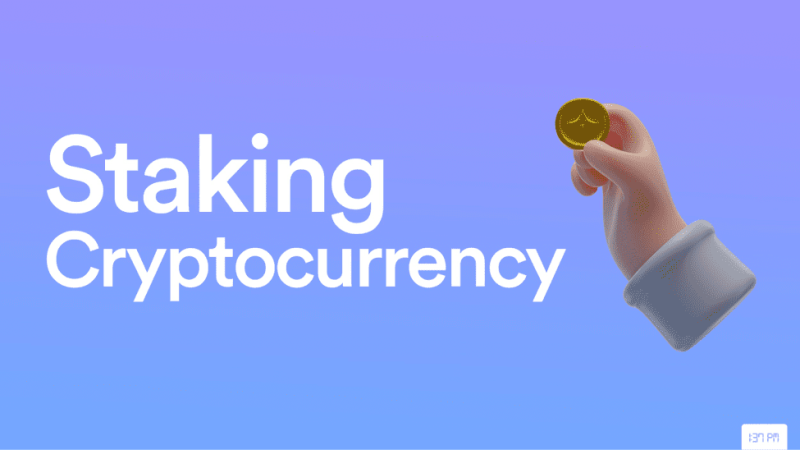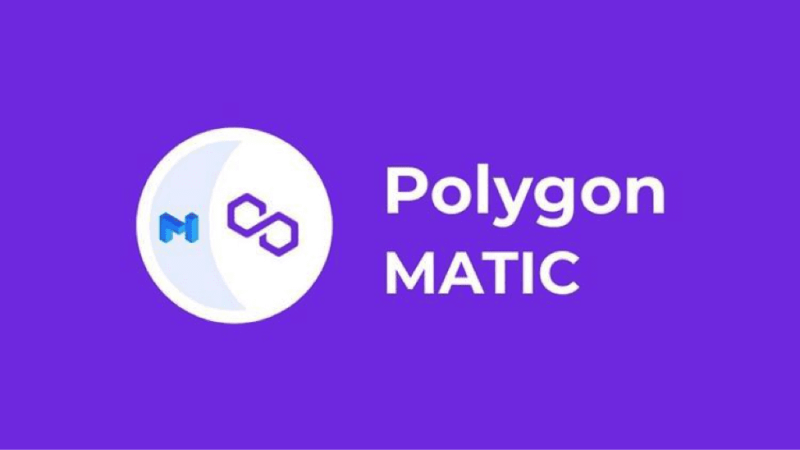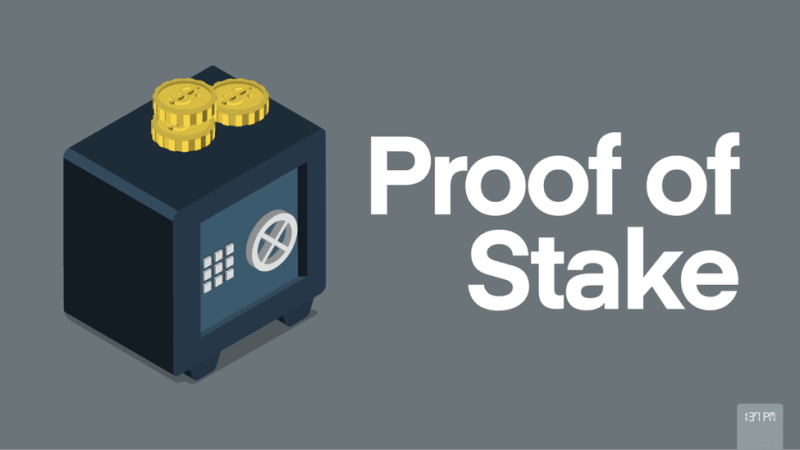
Also Read: Everything About Staking In Crypto
Contents
- What is Staking in Crypto?
- How Does Staking Work?
- What is Polygon (MATIC)?
- What is Proof of Stake?
- Polygon (MATIC) staking rewards
- Where to Stake MATIC Tokens
- How to Stake MATIC?
- Where to Buy MATIC Coin?
- Conclusion
- FAQs
What is Staking in Crypto?
Staking allows crypto owners to use existing crypto assets to work and earn staking rewards without having to sell those assets.

Staking may be compared to placing staked funds in a high-interest yield bank account in the world of cryptocurrencies. Whenever you put funds in your savings bank account, the institution usually takes it and loans it out to someone else. You get a share of the interest gained by borrowing in exchange for putting your cash in the bank account, although a very small percentage.
Likewise, whenever you stake your virtual tokens, you lock your tokens to help operate the blockchain and regulate the network security. You get paid a staking reward as a result of this. These profits are usually significantly larger than any institution’s rate of interest.
How Does Staking Work?
Staking would be only feasible thanks to the POS (proof of stake) consensus protocol, which really is a technique utilized by some blockchain systems to choose trustworthy users and validate new data blocks that are uploaded to the network.

It makes it unappealing to behave fraudulently in the network by requiring these network members who are referred to as stakers or validator(s) to acquire and lock up a specific quantity of tokens. If the blockchain is tampered with in any manner and acts maliciously, the delegated tokens connected with it will likely lose value, and the offender will take a loss.
The stake is the validator node, which ensures that they perform fairly and in the best interests of the network. Validators earn rewards in the local coin in return for their contribution. The greater the stake, the more likely they are to suggest a new blocks and reap the rewards. Admittedly, the more staked coins you have, the more inclined you are to be truthful.

The stake doesn’t need to be entirely made up of a user’s staked tokens. Validators often operate staking pools and generate cash from a set of holders by accepting delegations, decreasing the entrance cost to staking for additional users. Any user may partake in the staking process simply by putting delegated tokens to stake pool admins, who handle all of the hard work when it comes to confirming blockchain transactions.
To hold validators in line, simple infractions like remaining offline for lengthy periods of time might result in them being excluded from the agreement process and having their money taken away. Slashing staked funds is the last mentioned, and it has occurred on a variety of blockchains, like the Ethereum network.
What is Polygon (MATIC)?
To grasp Polygon’s function, it’s necessary to first describe Ethereum’s problems. The Ethereum network is the world’s largest smart contract blockchain network. If other network had the same amount of visitors similar to the Ethereum network, they could fall.
Ethereum, on the other hand, maintains its network functioning properly by rising gas prices. Higher costs are associated with increased traffic. There have been occasions where customers have had to spend over $200 for a $35 ETH transaction.

Once Eth 2.0 is released, those concerns should be resolved. We have, meanwhile, eagerly been expecting it for ages. Polygon ecosystem, a Layer-2 scaling solution for Ethereum, was created by a group of developers. Layer-2 solutions, in theory, function on the base of a certain network participating in the network’s functionality.
Polygon is a cryptocurrency that runs on Eth and incorporates the Plasma engine. This framework aids builders in the creation of off chain decentralized apps which are sometimes referred to as DApps. Furthermore, the Plasma framework delivers scalability, quickness, and excellent protection to building.
polygon network became prominent in 2021 as Ethereum’s visitors increased. The rise of NFTs (non-fungible tokens) sent much more activity to the Ethereum chain, resulting in greater charges and a poorer network. If you visit Wh you go to OpenSea, for example, you could come across NFTs that employ Eth on MATIC.
This implies you can buy those NFTs using Eth instead of incurring the hefty costs associated with Layer-1 Ether. Furthermore, numerous analysts predict that with the release of Ether 2.0, Layer-2 solutions would be obsolete.
Also Read: Coinbase vs Robinhood
What is Proof of Stake?
Proof of Stake (PoS) is a method that followed the well-known Proof of Work. PoW is often known as mining, and it is used to secure the system of digital currencies like BTC and Ethereum. This consensus technique necessitates the use of high-performance PCs to operate the system, which is often done decentralized. Contributors who offer their computational power to the system receive rewards in crypto.

The Proof-of-Stake process does not need the continuous operation of hundreds and thousands of workstations. It becomes more ecologically friendly as a result of this. Furthermore, you may participate in a PoS system by not trading and locking away your token to earn a staking incentive. This technique is used by EGLD, ADA, LUNA, Polygon, and SOL, among other coins. Nevertheless, not many of them employ the same Proof-of-Stake method. EGLD, for instance, employs a Secure Proof of Stake method.
In the cryptocurrency world, staking rewards are comparable to dividend payout in the stock exchange. The staking benefits, however, are unaffected by the market volatility of that particular digital currency. This is due to the fact that you receive your incentives in cryptocurrency rather than local currencies.
For instance, If you stake MATIC, you will claim your returns independent of MATIC’s price fluctuations. You’ll earn a part of the staking benefits if MATIC price rises. You will receive the same proportion of the staking benefits if MATIC price falls. The quantity of tokens you invested at the start, as well as the Annual Percentage Yield, are all that matters.
Polygon (MATIC) staking rewards
Polygon is a massive project with many of the characteristics that constitute a successful long-term investment. As a result, matic staking might bring you a lot of money. The average annual percentage yield for staking Polygon is about 9%. According to MATIC, there are over 2.3 billion MATIC tokens are presently staked in various node running services. Therefore, where and how should Polygon be staked?

Where to Stake MATIC Tokens
Cryptocurrency staking is typically quite simple. Most individuals purchase, sell, and trade bitcoins through major exchanges. Binance, Coinbase, FTX, Huobi, and Gemini, are among centralized exchanges where staked tokens like MATIC can happen. Obviously, whatever one you select is determined by your location. People in the USA, for instance, are more likely to prefer Coinbase over Binance due to Binance’s restrictions in the US.

How to Stake MATIC?
Buy Matic
First and foremost, you need to purchase MATIC. MATIC is available for purchase on both controlled and autonomous exchanges. Binance, FTX, KuCoin, Kraken, and other minor platforms are all good places to acquire MATIC. You may use Uniswap to buy MATIC on the blockchain platform.
Send polygon to staked tokens provider
You’ll need to send your polygon to a wallet after you’ve purchased the necessary quantity. The account you use is determined by the staking operator you select. You may utilize the exchange account, for instance, to lock up the MATIC in an exchange. You should utilize a quasi wallet like Trustwallet or Metamask if you want to hold some MATIC with another staking service, such as those indicated previously. Please double-check that the wallet you intend to use is supported by your staking operator before making your decision.
Stake Polygon
You’re ready to invest your MATIC once you’ve set up your wallet. The final step is to select a staking service and link your account to it. Simply input the quantity of MATIC you wish to stake and complete the order after that. Please do some research on the stake operator and double-check the URL you are utilizing. I say this because tens of thousands of individuals are routinely conned because they aren’t vigilant.
Where to Buy MATIC Coin?
MATIC is currently one of the most valuable crypto tokens in terms of market cap and crypto enthusiasts. As a result, MATIC may be purchased on most trading platforms, including Binance, Coinbase, Gate.io, Kraken, FTX, and a number of smaller ones.

Conclusion
Staking MATIC is an easy way to earn MATIC staking rewards, it has also a promising token to hold being that it is on the Ethereum network and helps reduce transaction fees. Long-term investors can earn rewards without a minimum limit to the amount of Polygon that can be staked.

The authorized tokens are not in the possession of validators. slashed delegated tokens, on the other hand, will be slit if a validator is destroyed.
FAQs
Can Matic be staked?
Tokens native to polygons Proof of Stock procedures are used by MATIC. The tokens you stake can be exchanged for cash and prizes. In the coming years, staking MATIC will benefit people.
What percentage of Matic is staked?
Your stakes will change depending on the current network circumstances and metrics such as the overall number of surges and activities performed on the system. The Matic token is being used to pay out a fresh 2% stake to clients.
How much can you earn by staking Matic?
The annual percentage yield (APY) of polygons is 8.2 percent.



